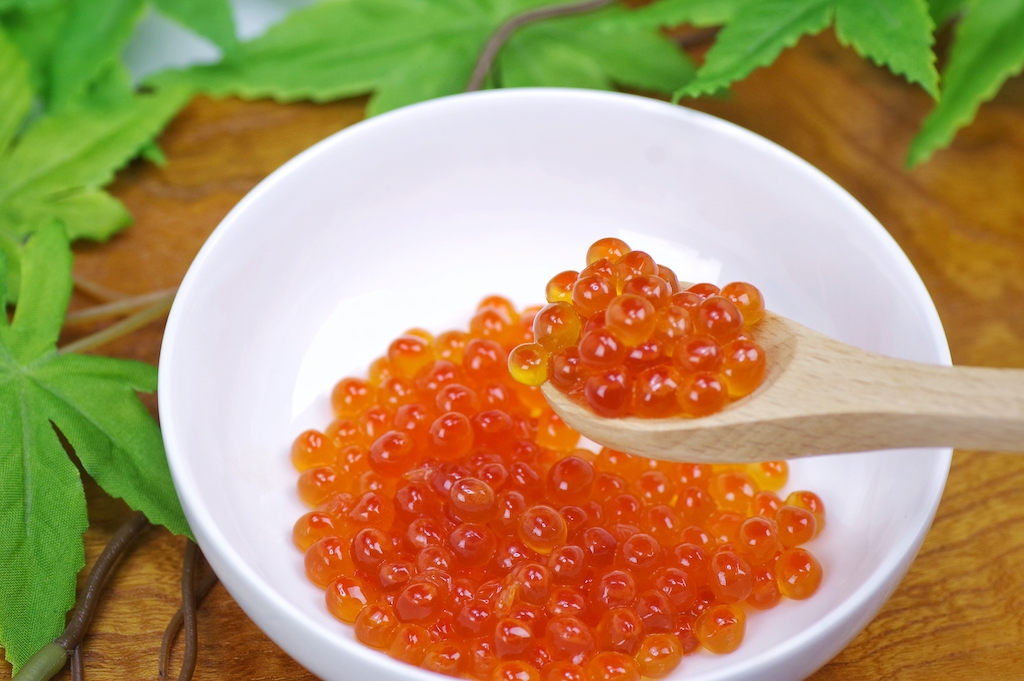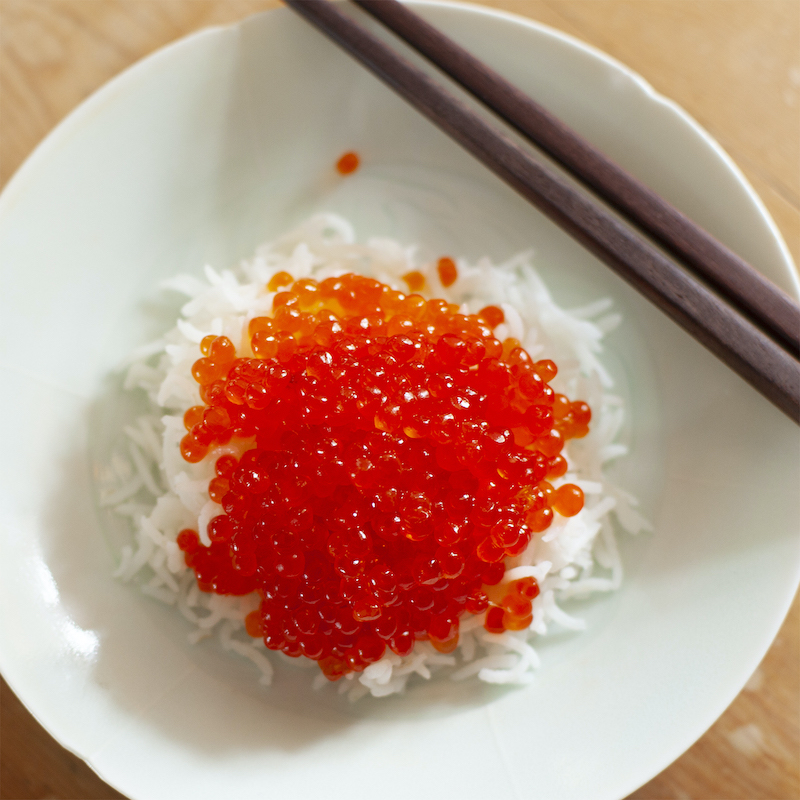What culinary treasure bursts forth with a symphony of flavor and texture, captivating palates with its vibrant color and oceanic essence? It's the captivating world of Ikura, the jewel-toned salmon roe that elevates dishes from simple to sublime.
More than just a garnish, Ikura, the Japanese term for salmon roe, is a delicacy in its own right, celebrated for its distinctive characteristics. These translucent, reddish-orange orbs, often referred to as "red caviar," offer a sensory experience that is both unique and unforgettable. Their soft, yielding texture gives way to a burst of briny flavor with a subtle fishiness that invigorates the senses. From sushi rolls to traditional Russian zakuski, the versatility of Ikura is a testament to its global appeal.
Let's delve deeper into the origins, preparation, and diverse culinary applications of this prized ingredient.
| Aspect | Details |
|---|---|
| Definition | Ikura (Japanese) or Red Caviar (often used) refers to the salted roe of salmon, known for its intense reddish hue. The term "Ikura" is derived from the Russian word for "fish eggs." |
| Origin | Predominantly associated with Japanese cuisine, Ikura is also found in Russian and other cultures. |
| Flavor Profile | Briny, with a mild fishiness and a slightly sweet aftertaste. |
| Texture | Soft, yielding texture with a satisfying pop in the mouth. |
| Uses | Sushi, sashimi, rice bowls (Ikura Don), appetizers, garnishes, and more. It is a popular ingredient in many different cuisines. |
| Preparation | Harvested from salmon, the roe is often separated, salted, and cured. It involves careful handling and precise ratios of salt, sake, sugar, and dashi soy sauce. |
| Storage | Best stored in the coldest part of the refrigerator, typically for a short period to preserve freshness and quality. |
| Related Terms | Red caviar, salmon caviar. |
The journey of Ikura begins with the salmon itself. The roe, or eggs, are harvested from the female salmon, a process that requires skill and care to ensure the eggs remain intact. The quality of the roe is paramount, and factors such as the salmon's diet and environment play a significant role in the flavor and texture of the final product. The harvesting methods vary depending on the region and the specific type of salmon.
Once harvested, the roe undergoes a meticulous salting process. This is a crucial step, as the salt not only preserves the roe but also enhances its flavor. The traditional method involves a brine solution, carefully calibrated to achieve the desired saltiness and balance. In some recipes, additional ingredients like sake, sugar, and dashi soy sauce are incorporated to further refine the flavor profile. The roe is then gently stirred or massaged in the brine, allowing the salt to penetrate and work its magic. After a specific resting period, the ikura is drained, and it is ready to be enjoyed.
The versatility of Ikura is one of its most appealing qualities. In Japan, it's a staple ingredient in sushi, often adorning gunkan maki, where it's nestled atop a mound of sushi rice and wrapped with nori seaweed. It also takes center stage in Ikura don, a simple yet elegant rice bowl where glistening, jewel-toned eggs are generously spooned over a bed of perfectly cooked rice. Beyond sushi, Ikura complements a wide array of dishes. It can be used as a vibrant garnish for salads, adding bursts of flavor and visual appeal, or it can be added to pasta dishes or even enjoyed on toast with cream cheese.
- Whitney Cummings Is A Mom Baby Joy Relationship Updates
- What Is Sheeko Somali Wasmo Qoraal On Facebook
In Russian cuisine, Ikura plays a role in zakuski, the array of appetizers that traditionally begins a meal. It's often served on buttered bread (butterbrot), offering a delightful combination of textures and tastes. Across cultures, from the delicate bite of a single egg to the generous spoonful over a bed of rice, Ikura's appeal endures.
The pursuit of the perfect Ikura extends beyond simply enjoying it. Chefs and home cooks alike often experiment with different methods of preparation, striving to unlock the ultimate flavor and texture. From the selection of fresh salmon roe to the precise measurements of salt and other seasonings, every step influences the final result. Some home cooks are attempting to transform fresh salmon roe into glistening vermillion gems of ikura and they are using sake, salt, sugar, dashi soy sauce, and a mesh grate to separate and cure the roe.
There are a few considerations for the consumer in relation to Ikura. The quality of the ingredient is key, and freshness is paramount. When purchasing Ikura, look for eggs that are plump, vibrant in color, and free from any discoloration. The aroma should be fresh, and the texture should be firm but yielding. It is also essential to store Ikura properly, as it is highly perishable. Keep it in the coldest part of your refrigerator, and consume it within a few days of purchase for optimal quality.
While the allure of Ikura is undeniable, it's important to be aware of its potential impact on the environment. The harvesting of salmon roe can sometimes have a negative impact on salmon populations if not managed sustainably. As consumers, we can support sustainable fishing practices by seeking out Ikura from reputable sources that prioritize responsible harvesting methods.
Looking ahead, it's clear that the fascination with Ikura will only continue to grow. As culinary boundaries blur and cultures blend, this ingredient will undoubtedly find new and exciting applications. From innovative sushi creations to unexpected pairings in global cuisines, Ikura's adaptability and unforgettable taste will secure its place as a beloved culinary staple. The Ikura's presence is also seen in festivals. For example, 2025/01/01 ikura's american festival is scheduled for May 25th (Sunday).
As the article unfolds, further content can detail on how to buy, store, and use Ikura in various dishes. The article can detail on its harvesting, salting process, and various ways to enjoy it in sushi, sashimi, or rice bowls.
In the world of Ikura, the possibilities are endless. It is a food that appeals to both the eye and the palate. It is a testament to the power of simple ingredients, transformed through skill and tradition into a culinary masterpiece.
Another perspective suggests the origin of "Ikura" is from the Russian word for "fish eggs." In Russia, this term encompasses all fish eggs, while in Japan, it specifically refers to salmon roe. The Japanese consider salmon roe, or Ikura, to be of the highest quality and use it in a variety of dishes.
For those seeking to savor the experience of Ikura, the options are many. From the convenience of ordering Japanese cuisine online from establishments like "ikura sushi & hibachi" in Port St. Lucie, Florida, to the authentic offerings of restaurants like "Welcome to ikura asian house", the quest for a delicious Ikura experience is accessible. The availability of fresh ingredients and the meticulous preparation methods promise an unforgettable taste. For those in Germany, "Wir ikura eisleben" offers freshly prepared sushi and other specialties. To enhance the experience, consider the following: take a medium-sized bowl (glass or stainless steel), add water and salt, and stir until the salt dissolves completely. After this, rinse the sack containing eggs under cool tap water to get rid of any residual blood.


